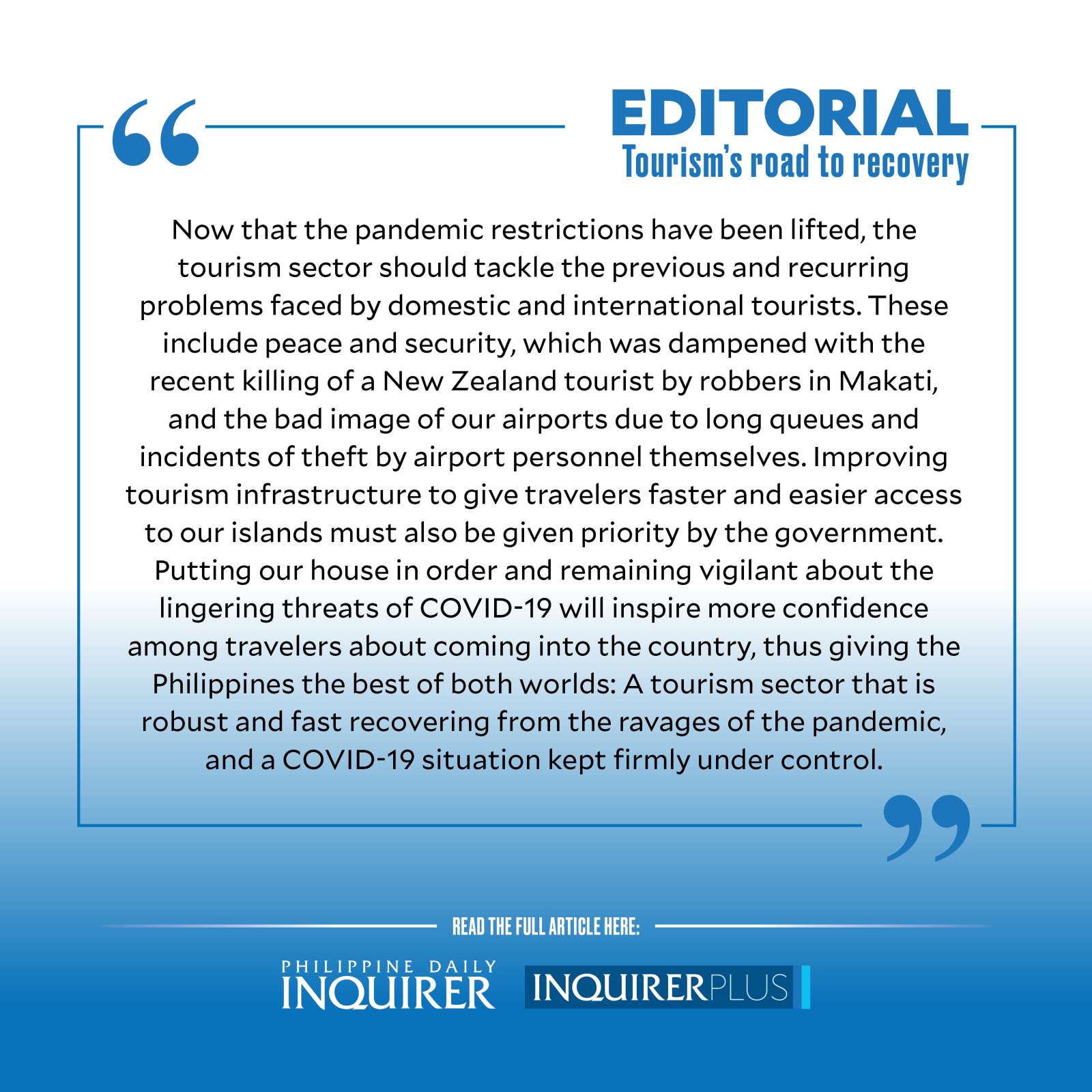
Revenge travel is in full swing three years after COVID-19 struck the Philippines, a momentum that the Department of Tourism (DOT) intends to maintain by dismantling the last of the health and safety protocols imposed on tourism establishments. Earlier this week, DOT issued Memorandum Circular 2023-0002 that lifted more pandemic era regulations to spur the rapid recovery of the critical tourism sector that was crippled by the extended lockdowns and stringent movement restrictions of previous years. Tourism establishments, for one, no longer need to install plastic or acrylic barriers and dividers in designated areas, nor are they required to display signs or visual cues on mandatory protocols. Guests, too, are no longer expected to wear face masks, nor are they required to present proof of full vaccination.
Tourism Secretary Christina Frasco said doing away with these increasingly obsolete requirements “sends the important message that, under the Marcos Jr. administration, our country is open for tourism, and that we are keeping up with global practices on tourism operations that have already opened up worldwide.” Indeed, DOT has made a series of calibrated moves to fully reopen the battered tourism sector, one of President Marcos Jr.’s stated priorities during his first State of the Nation Address.
According to the Philippine Statistics Authority, the tourism sector contributed as much as P1 trillion to the economy in 2021, 9.2 percent more than its P917.2 billion earnings in 2020, when mobility restrictions were at their most stringent. The tourism industry, which covers hotels, food and beverage outlets, travel agencies, tour operators, retail establishments, tour guides, recreation, and transportation also employed 4.9 million in 2021, accounting for roughly 11 percent of total employment in the country. This meant that at least one in every 10 employed Filipinos was in the tourism sector. But the current figures have a long way to go to match DOT’s output in 2019, when it contributed P2.5 trillion to the economy and employed 5.7 million. This explains the rapid loosening of travel restrictions, as the Marcos Jr. administration struggles to attract at least 8.3 million tourists, the number of tourist arrivals in 2019 before the global health emergency hit the country.
To recall, Mr. Marcos signed in October last year Executive Order No. 7 that made the wearing of face masks voluntary throughout the country, except in critical areas such as in health care facilities and all types of public transport, to better compete for tourists against other countries that had long lifted their mask mandates. Since then, other strict requirements such as prior testing and mandatory quarantine had been removed, as was the issuance of safety seal and safe travels stamp to establishments complying with COVID-19 protocols.
But while packed hotels, restaurants, and incoming flights clearly indicate that the sector is fast regaining its pre-COVID vigor, Filipinos should not be lulled into thinking that the pandemic is over. On the contrary, COVID-19 remains a threat, as the Department of Health (DOH) keeps stressing. Reasonable caution should still be exercised lest new and more transmissible strains cause infection numbers to again spin out of control, and justify the reinstatement of painful protocols. Basic and easy-to-follow health and sanitation rules should remain in place to protect ourselves and others from contracting the virus that causes COVID-19 as well as other diseases. These include the thorough washing of hands, wearing a face mask when warranted, and voluntarily isolating one’s self or changing travel plans when symptoms of illness appear. The withholding of information about a traveler’s health status should not be tolerated.
One heartening note amid these precautions is the DOH’s pronouncement that 73.8 million Filipinos or 94.6 percent of the target population are now fully vaccinated against COVID-19, which helps keep the country’s positivity rate well below the 5 percent deemed manageable by the World Health Organization.
Now that the pandemic restrictions have been lifted, the tourism sector should tackle the previous and recurring problems faced by domestic and international tourists. These include peace and security, which was dampened with the recent killing of a New Zealand tourist by robbers in Makati, and the bad image of our airports due to long queues and incidents of theft by airport personnel themselves. Improving tourism infrastructure to give travelers faster and easier access to our islands must also be given priority by the government.
Putting our house in order and remaining vigilant about the lingering threats of COVID-19 will inspire more confidence among travelers about coming into the country, thus giving the Philippines the best of both worlds: A tourism sector that is robust and fast recovering from the ravages of the pandemic, and a COVID-19 situation kept firmly under control.

